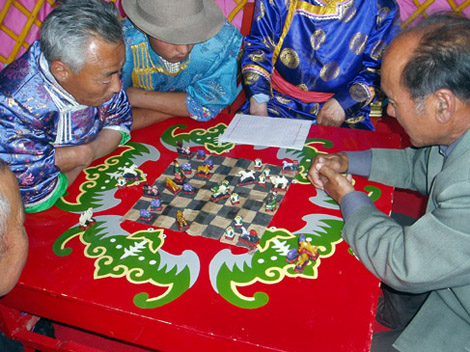
The Mongolian chess is a popular sport game in Inner Mongolia. It's also one of the most attractive items on the Nadam Fair.
The Mongolian chess is quite similar to Xiangqi, or Chinese chess, but the form, rules and ways to move the chess pieces are more like international chess. Called "Shatar" in the Mongolian language, the Mongolian chess is said to have been introduced into the area way back in the period when Genghis Khan went on his western expedition. The chess was revolutionized according to Mongolian practice, and unique ways to move the chess pieces were formed. When the Mongolian people rose to power, they entered farming areas from grasslands. To break up city walls, they learnt to make stone-throwing machines from the Jin people. After that, they also mastered the techniques of making gunpowder cannons, which became the important weapons of Mongolian troops for attacking cities and forts. The cannon, along with other weapons and military tactics, was re-enacted on a chess board, bringing us an intelligent game.
Following Genghis Khan's western expedition, the board game was spread to grassland areas in the 1230s before it was introduced to Europe. It was brought to the Mongolian people via Persia, thanks to the extension of the "Silk Road" through the Mongolian grasslands. The board of the game is a square board with 64 small squares of two different color shades alternating with each other. It is pretty much the same as the board of international chess. The light-colored squares are called "white squares" and dark-colored ones "black squares". The chess pieces are also in black and white, with each color representing one of the two players. There are a total of 32 pieces, with 16 for each player, including one king, one commander-in-chief, two chariots, two elephants, two horses and eight soldiers. What's unique about the Mongolian chess is that the elephant pieces are made into camels and soldiers are made into hunting dogs, adding some flavor of nomad life on the grassland.
We recommend:
